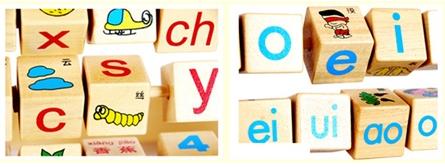Pinyin
By admin on 2015-06-07

Chinese phonetics is called Hanyu Pinyin in Chinese. It was approved in 1958 and adopted in 1979 by the Chinese government and superseded older Romanization systems such as Wade-Giles, Chinese Postal Map Romanization as well as Zhuyin, the method of Chinese phonetic instruction in China. Hanyu Pinyin was adopted in 1979 by the International Organization for Standardization (IOS), and Library of Congress of the U.S., the American Library Association as well as many other international institutions. It has also become a useful tool for entering Chinese language text computers.
The primary purpose of Hanyu Pinyin in Chinese schools is to teach Standard Putonghua (common language) Chinese (SPC). For those Chinese who speak Putonghua at home. Hanyu Pinyin is used to help children associate characters with spoken words which they already know; however, for the many Chinese who do not use Putonghua at home. Hanyu Pinyin is used to teach them the standard pronunciation of words when they learn them in elementary schools.
What is Hanyu Pinyin then? It is the official system representing Standard Putonghua Chinese with the Roman alphabet. One needs to practice these sounds to begin with until one sounds like the native speaker. Hanyu Pinyin is also a way to represent Chinese characters and express the sounds in the Chinese language using the alphabet. These are other systems to express Standard Putonghua Chinese, but Hanyu Pinyin is the most accepted and widely used. Once you learn Hanyu Pinyin you will know how to pronounce any word in Standard Putonghua Chinese using a Chinese dictionary. Hanyu Pinyin is also the most common way to input Chinese characters into a computer. Although Hanyu Pinyin and English both use the Roman alphabet, many letters are not expressed with the same sounds that English uses.
There are three parts in Chinese Hanyu Pinyin: the initial, the final, and the tone. The tone, initial, and final are described and represented as follows.
Pinyin is made up of syllables. Each syllable contains mainly three parts: tone, initial and final. For example:
- Contact Us
-
Tel:
0086-571-88165708
0086-571-88165512E-mail:
admission@cuecc.com
- About Us
- Who We Are What we do Why CUECC How to Apply
- Address
- Study in China TESOL in China
Hangzhou Jiaoyu Science and Technology Co.LTD.
Copyright 2003-2024, All rights reserved




 Chinese
Chinese
 English
English
 Korean
Korean
 Japanese
Japanese
 French
French
 Russian
Russian
 Vietnamese
Vietnamese
